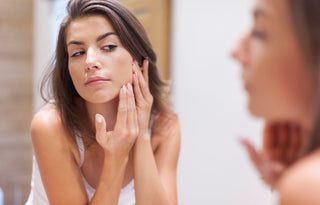We all want hydrated, gorgeously glowing skin. But what if you're finding your complexion to be rough, tight, flaky, or dull? You might think you have dry skin, but your skin could actually be dehydrated. Keep reading to find out whether your skin is dry or dehydrated, and how to treat dehydrated skin.
My Experience with Dehydrated Skin.
I had my first run-in with dehydrated skin when I was in high school. In an attempt to curb teenage acne, I was using all kinds of drying products. Apricot scrub, stinging astringents, benzoyl peroxide – you name it, I was putting it on my face!
Not only did this NOT clear up my acne, but my skin also became red, itchy, flaky, and dull. So what was the deal? Why was my skin getting worse instead of better?
What is Dehydrated Skin?
Fed up with my inflamed and broken out skin, I finally went to see my dermatologist and what she said shocked me. I didn't have some foreign, mysterious ailment - instead, my dermatologist diagnosed me with dehydrated skin.
Dehydrated skin is a skin condition where the top layer of the skin, called the stratum corneum, lacks water. This lack of water is due to TransEpidermal Water Loss (TEWL). TEWL is a fancy name for when water evaporates out of your skin.
Since I’ve always had oily skin, it never occurred to me that I could have dehydrated skin. But it turns out that all skin types can develop dehydrated skin, even oily types! Whereas dry skin may develop into dehydrated skin because it struggles to hold onto moisture, oily skin can become dehydrated skin from using harsh products.
Dehydrated skin may have many causes, including:
- Over-exfoliating skin
- Washing face with too-hot water
- Use stripping cleansers or toners
- Dry air/low humidity (such as in desert climates or in cold climates during the winter)
- Seasonal changes
- Sunburn or windburn
- Exposure to cigarette smoke
Any of these can damage your skin’s protective lipid layer, leading to TEWL.
We’ll talk soon about how to repair dehydrated skin, but first, let’s talk about how to tell if your skin is dry or dehydrated.
What Is the Difference Between Dry vs. Dehydrated Skin?
In short: dry skin is a skin type, dehydrated skin is a skin condition. Dry skin is caused by genetics, whereas dehydrated is caused by external factors like products and climate (see below).
Symptoms of dry skin:
- Feels rough
- Appears dry
- Can be flaky
- Looks dull
Symptoms of dehydrated skin:
- Skin looks dry, flaky, or scaly
- Feels tight
- Overly sensitive and itchy
- Looks dull
- Redness or splotches
- Acne, particularly if you have oily skin
While there’s some overlap between the symptoms, keep in mind that if you have dry skin, you’ve probably always had it. Dehydrated skin is temporary, though it can last a long time.
How to Improve Dehydrated Skin
The trick to fixing dehydrated skin is to repair the protective lipid barrier of the skin. This will help to stop water loss.
Here’s how to do it:
1. Wash your face using a cream cleanser or oil cleanser and lukewarm (not hot) water.
2. Apply a product with skin-identical lipids. Look for ingredients like ceramides, cholesterol, fatty acids, squalane, and urea.
3. Hydrate with RAPID REPAIR Facial Moisturizer. This moisturizing cream soothes irritated skin with Azulene and Chamomile Extract while locking in hydration with avocado oil and grape-seed oil. Just like I would drink a chamomile tea to settle an upset stomach, the chamomile in the cream works to soothe, calm, and destress my stressed skin. Plus, it’s amazing for even the most sensitive skin.
4. Cut out all skincare products with active ingredients like retinoids until your skin heals.
5. Drink plenty of water and cut down on alcohol and caffeine, which are dehydrating.
6. Use sun protection, since exposure to UV radiation can dry out the skin.
7. Sleep with a humidifier, aiming for 40-60% indoor humidity.
If you follow these steps, you should see instant results as well as improvement over time. Then you can start to slowly introduce other products into your skincare routine.
Have you ever experienced dehydrated skin? How did you fix it? Let me know in the comments!




